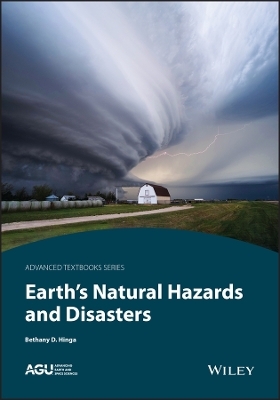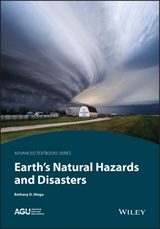Earth's Natural Hazards and Disasters
American Geophysical Union (Verlag)
978-1-119-21771-8 (ISBN)
Earth’s Natural Hazards and Disasters is a textbook for undergraduates that challenges students to think critically about disasters. It explains the science behind natural events and explores how to understand risk and prepare for disasters.
About this volume:
- Covers hazards in the geosphere, hydrosphere, atmosphere, and biosphere
- Explains the science of hazards in accessible terms
- Detailed case studies of specific disasters for each type of natural event
- Explores data-based risk mitigation strategies
- Discusses the roles of scientists, public officials, and the general public in hazard management
The proposed textbook is an introductory textbook for first-year non-major undergraduate students. It will use non-technical language and explain the fundamentals of natural disasters to the novice. The book may be used by university and community college classes, and advanced high school classes. It is most likely to be used in departments of Geology, Geography, Earth Science, Physical Science and Environmental Science.
It may also prove useful to federal government agencies such as the Federal Emergency Management Agency (FEMA), the Environmental Protection Agency (EPA), and the Department of Homeland Security, as well as to state Emergency Management organizations, and to first responders training to respond to specific events in their communities.
Bethany D. Hinga, PhD, is Assistant to the Senior Vice Chancellor for Academic Affairs, Director of Assessment, and a professor in the Department of Geology at the University of Nebraska Kearney, USA. She has extensive teaching, research, and administrative experience.
Contributors xiii
Preface xv
Glossary xvii
Acknowledgments xlv
1 Introduction to Natural Disasters 1
Bethany D. Hinga
1.1 Introduction 1
1.2 The Earth System 4
1.3 Natural Disasters 7
1.3.1 Types of Disasters 7
1.4 Definitions 8
1.5 Disasters Are Predictable 9
1.6 The Human Factor 13
1.7 Increasing Risk 14
1.8 Calculated Risks 16
1.9 The Role of Government in Vulnerability and Preparing for Disasters 18
1.10 Disasters and Social Change 21
1.11 Community Response 21
1.12 Chapter in Review 25
Part I Geologic Events as Hazards
2 Plate Tectonics 31
Bethany D. Hinga
2.1 Introduction 31
2.2 Continental Drift 31
2.3 New Data: Magnetism 35
2.4 Seafloor Spreading 38
2.5 Plate Tectonics 38
2.6 Earth Structure 38
2.7 Plate Boundaries 40
2.8 Subduction Zones 45
2.9 Collision Zones 48
2.10 Transform Boundaries 49
2.11 Hotspots 51
2.12 Conclusion 54
2.13 Chapter in Review 54
3 Volcanoes 57
Bethany D. Hinga
3.1 A Lengthy Eruption With an Unexpected End 57
3.2 Magma Generation 64
3.3 Volcano Behavior 70
3.4 Types of Volcanoes 72
3.5 The Case of Mount St. Helens 83
3.6 Hazards of Composite Volcanoes 90
3.7 Mitigation 96
3.8 Chapter in Review 97
4 Earthquakes 101
Bethany D. Hinga
4.1 Introduction 101
4.2 What Is an Earthquake? 107
4.3 Seismic Waves 111
4.4 How Do Earthquakes Work? 123
4.5 Earthquake Hazards 129
4.6 Prince William Sound Earthquake 138
4.7 Mitigation Strategies 139
4.8 Conclusion 142
4.9 Chapter in Review 142
5 Tsunamis 145
Bethany D. Hinga
5.1 Introduction 145
5.2 Unimak Island Earthquake and Tsunami, 1946 145
5.3 Wave Creation 149
5.4 Wave Characteristics 150
5.5 Wave Parameters 152
5.6 Case Studies 153
5.7 Landslide-Generated Tsunami 161
5.8 Mega-Tsunamis 161
5.9 Volcano-Generated Tsunamis 161
5.10 Mitigation of Tsunami Hazards 164
5.11 Conclusion 166
5.12 Chapter in Review 166
6 Earth Movements 169
Bethany D. Hinga
6.1 The Role of Gravity in Shaping the Earth 169
6.2 Venezuela, 1999 169
6.3 Types of Earth Movements 172
6.4 Mass-Wasting Triggers 188
6.5 Mitigation of Hazards 188
6.6 Conclusion 192
6.7 Chapter in Review 193
Part II Weather and Climate as Hazards
7 Atmosphere and Weather 197
Bethany D. Hinga
7.1 Introduction 197
7.2 The Earth's Atmosphere 197
7.3 Solar Radiation 199
7.4 Weather 202
7.5 Air Masses and Fronts 212
7.6 High and Low Pressure Systems 214
7.7 Conclusion 217
7.8 Chapter in Review 217
8 Severe Weather 221
Bethany D. Hinga
8.1 Blizzard on the Plains 221
8.2 Severe Weather Events 225
8.3 Conclusion 251
8.4 Chapter in Review 252
9 Floods 255
Bethany D. Hinga
9.1 Introduction 255
9.2 Central China Flood 255
9.3 The Nature of Streams 258
9.4 Types of Floods 265
9.5 Flood Mitigation 274
9.6 Chapter in Review 278
10 Hurricanes 281
Bethany D. Hinga
10.1 Introduction 281
10.2 Hurricane Maria, 2017 281
10.3 Tropical Cyclones 287
10.4 Hurricane Hazards 295
10.5 Mitigation 304
10.6 Conclusion 304
10.7 Chapter in Review 305
11 Climate Change 307
Jillian Gregg and John Helms
11.1 Slushballs and Greenhouses: What the Geologic Record Says About Paleoclimate Compared to the Current Stable Climate That Has Supported Human Civilization Over the Past 10,000 Years 307
11.2 Climate Change Basics 310
11.3 Natural Hazards Caused Directly and Indirectly by Greenhouse Gas Emissions and Climate Change 334
11.4 Ocean Impacts 351
11.5 Mitigation of Hazards 356
11.6 Geoengineering 361
11.7 Adaptation 363
11.8 Chapter in Review 365
12 Wildland Fires 369
Bethany D. Hinga
12.1 Introduction 369
12.2 Fire Basics 372
12.3 Fire Behavior 375
12.4 Firefighting in Public Lands 382
12.5 Mitigation of Fire Hazards 386
12.6 Conclusion 387
12.7 Chapter in Review 387
Part III Other Hazards
13 Biological Hazards With COVID-19 Case Study 393
Anni Moore and Austin Nuxoll
13.1 Biological Disasters 393
13.2 Introduction to Microbes 397
13.3 Types of Microbes 398
13.4 Microbes and the Earth System 411
13.5 Factors That Put Populations at Risk 415
13.6 Diseases in the Food Supply 422
13.7 Mitigation of Hazards 423
13.8 Conclusion 428
13.9 Chapter in Review 429
14 Hazards From Space 433
Kelli Wakefield and Joel Berrier
14.1 Space Hazards 433
14.2 Introduction 434
14.3 A History of Catastrophe 434
14.4 Measuring Risk 445
14.5 What Can We Do? 456
14.6 Solar Events 459
14.7 Earth's Future 463
14.8 Chapter in Review 463
Bibliography 467
Index 483
| Erscheinungsdatum | 14.09.2020 |
|---|---|
| Reihe/Serie | AGU Advanced Textbooks |
| Verlagsort | Bognor Regis |
| Sprache | englisch |
| Maße | 178 x 252 mm |
| Gewicht | 1089 g |
| Einbandart | kartoniert |
| Themenwelt | Naturwissenschaften ► Biologie ► Ökologie / Naturschutz |
| Naturwissenschaften ► Geowissenschaften ► Geologie | |
| Naturwissenschaften ► Physik / Astronomie | |
| ISBN-10 | 1-119-21771-7 / 1119217717 |
| ISBN-13 | 978-1-119-21771-8 / 9781119217718 |
| Zustand | Neuware |
| Informationen gemäß Produktsicherheitsverordnung (GPSR) | |
| Haben Sie eine Frage zum Produkt? |
aus dem Bereich




